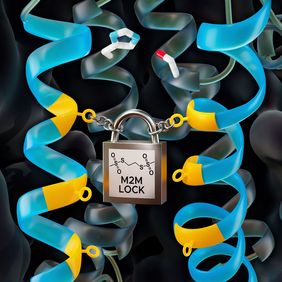Researchers from the Leibniz-Forschungsinstitut für Molekulare Pharmakologie (FMP) and UniSysCat recently published a paper in the journal Science Advances, about uncovering a crucial mechanism for regulating rhomboid protease activity. Rhomboid proteases are a group of enzymes located in the cell membrane of almost all species1, responsible for cleaving other proteins and initiating vital signaling cascades within cells. Due to their significant involvement in various biological processes and their potential relevance in treating diseases such as Parkinson's, malaria, and cancer, they have emerged as promising targets for drug development. However, the study of these intramembrane proteins presents numerous challenges due to their complex location.
The Gate
Their location in the cell membrane posed some puzzles to researchers: how do the substrates, for example the transmembrane proteins that are cleaved by the rhomboid proteases, even reach their active site? After all, the active site, or catalytic center, is hydrophilic while the surrounding lipid bilayer of the cell membrane is hydrophobic, so this access doesn’t happen naturally. In 2019, Professor Adam Lange's research group at FMP captured dynamic images of rhomboid proteases using solid-state NMR spectroscopy. This work confirmed the existence of a lateral "gate", consisting of two transmembrane helices, that momentarily opens to enable substrates access to the active site of the rhomboid proteases.
Correlation Between Gate Dynamics and Protease Activity
Building on their previous work, the researchers at FMP conducted further studies in collaboration with UniSysCat to explore the significance of the gate for rhomboid protease functioning. Their newest findings, discussed here, demonstrate a clear correlation between gate dynamics and protease activity.
Combining Experimental and Theoretical Approaches
To gain a comprehensive understanding of how rhomboid proteases function, the researchers employed a combination of experimental and theoretical techniques. Solid-state NMR spectroscopy, biophysical methods, biochemical functional assays, and molecular dynamics simulations all played a role in their investigation. “It truly was a highlight of this work,” remarked project leader Adam Lange.
Using a biophysical model, the researchers created various mutants of rhomboid proteases from E. coli bacteria (GlpG), with either a movable or closed gate (by introducing a maleimide-maleimide (M2M) crosslink, see picture). Their experiments revealed that mutations promoting easier gate opening increased protease activity, while a closed gate resulted in halted activity, preventing substrates from being processed.
Professor Han Sun's research group performed molecular dynamics simulations to complement and extend the experimental results. “We were able to simulate on the computer exactly how wide the gate has to be open to let substrates through,” explained Han Sun.
Implications for Drug Development
Rhomboid proteases have become a crucial target for drug development due to their role in various diseases. These new findings provide valuable insights that could catalyze significant progress in drug discovery efforts. FMP doctoral student Claudia Bohg, lead author of the study, is actively involved in the search for new compounds, which is also taking place at FMP. “The new findings will no doubt help us make significant progress in this area, too,” she commented.
Publication
Claudia Bohg, Carl Öster, Berke Türkaydin, Michael Lisurek, Pascal Sanchez-Carranza, Sascha Lange, Tillmann Utesch, Han Sun, Adam Lange. The opening dynamics of the lateral gate regulates the activity of rhomboid proteases, Science Advances, DOI: 10.1126/sciadv.adh3858
1: leibniz-fmp.de/newsroom/news/detail/how-rhomboid-protease-activity-is-regulated



